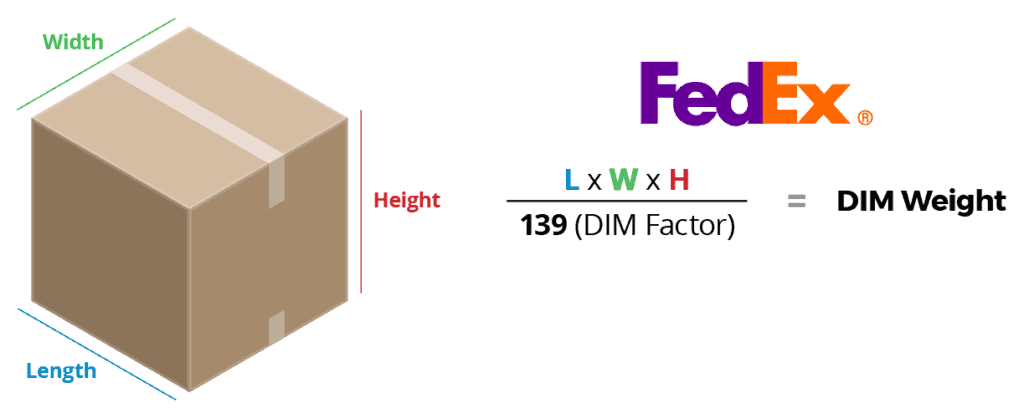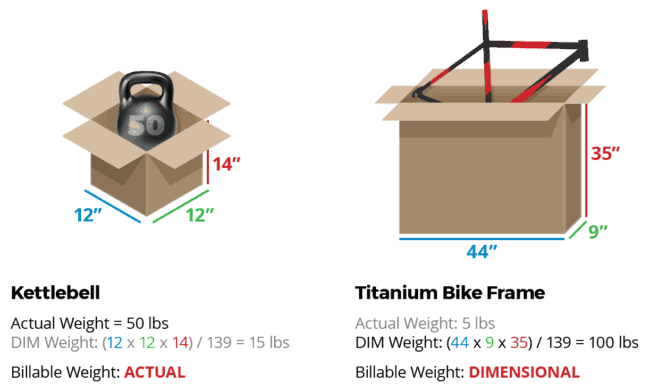This post is by Jake Rheude, the Director of Marketing for Red Stag Fulfillment.
Shipping costs used to be based on the total weight of a package. It didn’t matter if you were shipping lead weights or helium-filled balloons – a heavy box would always cost more to send than a light box.
Then in 2015, both UPS and FedEx announced that shipping charges would be based on the actual weight of a package or its “dimensional weight”, whichever was greater. Other couriers and logistics companies have followed suit in the years since then.
So today, sellers have to think about packages in two different ways. The weight still matters, but so does the volume. The secret of dimensional weight is that it has nothing to do with the actual weight of a package – it’s just about volume.
Here’s everything online sellers need to know about dimensional weight, from how to calculate it, why it exists and how to cut costs.
What is dimensional weight?
Dimensional weight – often shortened to “DIM weight” and sometimes called “volumetric weight” – is an alternative theoretical weight of a package used by couriers to determine the shipping cost. It takes the volume of the box then applies a factor (or divisor) to arrive at a theoretical weight of the package.
The weight used in the shipping cost calculation is whichever is larger: the actual weight or the theoretical DIM weight.

Carriers are limited by the total weight that a truck or other vehicle can carry and the physical space available to hold packages in transit. Standard shipping prices focus on weight. DIM weight calculations focus on the physical space.
Remember that DIM weight is not weight – it’s only based on volume. The factor (or divisor) that is applied effectively converts the real volume in cubic inches to a theoretical weight in pounds.
If your package is heavier than that theoretical DIM weight, then the actual weight is used as normal. But if it is lighter than the theoretical DIM weight then the DIM weight is used instead of the actual weight.
It’s a way of taking volume into account for packages that are below a certain density (the ratio of weight to volume) so packages that are light for their size will be charged as if they are heavier.
How do I calculate dimensional weight?
To calculate dimensional weight, first get the volume of your package – that’s length times width times height. If your package is not a regular box shape, use the longest dimension for each of length, width and height.
When you have the volume, divide it by the “DIM factor” of the carrier who will ship your package.
Current DIM factors are:
- USPS: 166
- FedEx: 139
- UPS: 166 for the retail rate (139 for daily rates)
- DHL: 139
Once you do that math, round up the total to the next whole number, and that’s your DIM weight.
Note that the USPS only applies DIM weight pricing for packages with a volume larger than 1,728 cubic inches (equivalent to a box measuring 12 inches in length, width and height), and only on zones five and higher. The actual weight will be used otherwise.

Here’s an example:
- Let’s say a package measures 10 inches in every direction, and weighs 7.5 lbs.
- The volume works out as 1000 cubic inches (10 x 10 x 10).
For FedEx
- Divide 1000 by 139 to get 7.19. Then round it up to get the DIM weight of 8 lbs.
- The shipping cost will be based on the DIM weight of 8 lbs, because it is more than the actual weight.
For UPS:
- Divide 1000 by 166 to get 6.02. Then round it up to get the DIM weight of 7 lbs.
- The shipping cost will be based on the actual weight of 7.5 lbs, because it is more than the DIM weight.
Of course, the actual shipping cost might not be more with FedEx than UPS because there are many other factors taken into account such as the shipping speed and destination. But it’s useful to remember from this that a higher DIM factor is better.
Why was dimensional weight introduced?
As mentioned above, dimensional weight helps carriers charge based on how much space a parcel takes up on their truck.
If charging was based only on weight, you could ship enough air-filled bags to take up an entire truckload, but pay only a few dollars because the weight would be so low. DIM weight allows a more accurate reflection of the costs of transporting a full truckload, even if the packages it contains are very light.
The rise in ecommerce played a role in the creation of DIM weight. Delivering many more packages to many more homes each day took up a lot of capacity on trucks and vans. Ecommerce packages are often single products packed in large boxes and padded with a lot of light packing material such as brown paper, bubble wrap and air-filled bags. That’s very different to a pallet of closely packed products being shipped between warehouses.
How much is dimensional weight costing my business?
You can check if dimensional weight is affecting your shipping costs by running the calculation for a sample of packages that you send. Measure a package and weigh it, then calculate the DIM weight as above. Your carrier will use whichever is larger: the DIM weight or the actual weight.
We have a calculator at Red Stag Fulfillment which takes your package dimensions and determines the DIM weight and price estimates across all zones for UPS, USPS, and FedEx. It also takes account of the USPS only using DIM weight for packages larger than 1,728 cubic inches, and only on zones five and higher.
If a lot of your sample packages have a DIM weight higher than the actual weight, then dimensional weight could have an impact on your business. If you see DIM weights that are much higher than actual weights, that could indicate an opportunity to reduce the package size and make substantial savings – there’s more on that below.
How do DIM weights differ between FedEx, UPS, DHL, and USPS?
Every carrier uses DIM weight for the same purpose – to account for package volume in shipping prices. The key difference is the DIM factor (or divisor) that they apply. DIM factors – the number you divide your package volume by – are set by each carrier individually. Over the years, they have changed and sometimes been the same and sometimes been different.
What’s important for you is that a higher DIM factor means the calculated DIM weight will be lower, and therefore DIM weight will apply less often.
Let’s put that into more concrete terms. Say you want to ship a 10” x 10” x 10” package that weighs 7.5 pounds. The volume is 1,000 in3 and we’ll get DIM weights by dividing by those DIM factors, to get this chart:
| Carrier | Volume | DIM Factor | DIM Weight |
|---|---|---|---|
| DHL | 1,000 in3 | 139 | 8 lbs |
| USPS | 1,000 in3 | 166 | 7 lbs* |
| FedEx | 1,000 in3 | 139 | 8 lbs |
| UPS (retail) | 1,000 in3 | 166 | 7 lbs* |
| UPS (daily) | 1,000 in3 | 139 | 8 lbs |
If you use a DHL calculator that asks for measurements in cm and kg, the DIM factor to use is 5,000. This nice round number is almost exactly the same as the DIM factor of 139 for inches and pounds. Generally speaking, DHL import and shipments within the UK use the metric system. DHL export uses inches and pounds.
The last difference to note is final cost. DIM weight is just one piece, so carriers may charge different prices for the same package going to the same location. Simply reducing package volume might not result in the best price for your shipments.
If you’re working with a 3PL or you ship high volumes of products each week, DIM factors can be negotiated. The deals you can agree will vary by how much you ship and your carrier options, so always shop around and see who will offer what kinds of savings.
Do Amazon FBA fees use dimensional weight?
Yes, Amazon does use dimensional weight as one of its two calculations to determine the fulfillment cost if you’re using FBA. However, this only applies to goods that are in its “standard size” category and weigh more than one pound, and goods in its “oversize” category. Here are the company’s product size tiers. Amazon uses a DIM factor of 139.
If you use FBA, one thing you’ll really want to monitor is the product dimensions and weight data you provide to Amazon. They will check these from time to time and adjust your costs accordingly. Mistakes can happen, and potentially push your FBA fulfillment fees up. So, keep an eye on your product data changing, and check that any adjustments are correct.
Bear in mind that Amazon charges different FBA fees for each country, so check all rates that could apply.
Who is most affected by dimensional weight?
Companies that ship lightweight products are the most likely to be impacted by the DIM weight calculation. If you’re shipping something small and heavy, like weights and workout equipment, you’ll most likely be paying based on the actual weight of every shipment.
Thin plastic goods and large, hollow metal items are ones that commonly use DIM weight pricing. A titanium bike frame, for example, will have a significantly higher dimensional weight than its actual weight.

Large plastic bowls and utensils are also likely to be billed by dimensional weight, as are many irregularly shaped products. An item that has to be packed diagonally into a large box, with the empty space filled with packing material, is likely to be charged based on its DIM weight.
Sometimes, packaging will also make a difference. Some glass items, such as a small vase, may have a low weight but require a lot of wrapping and filler materials to protect them, adding volume.
How can I reduce the dimensional weight of my shipments?
Dimensional weight can be reduced by making your packages smaller. There are a few standard options for doing this. But remember, there will be no cost saving for packages that are already billed based on their actual weight. Likewise, your potential savings for packages that are billed on DIM weight will max out at the point where you begin paying based on actual weight.
Start by seeing if you can fit your product in a smaller box – safely. If you’re using a single box size for every order, but your products vary in size, you could be paying more than you need. Try to maximize space utilization and slim down the box whenever possible.
You can also change the materials you use to wrap and protect your products. If you shift away from bulky fillers to thinner ones, your product can fit in a smaller box with a lower volume.
You could consider removing a product from its original package to ship it in a much smaller box, if the factory packaging contains a lot of empty space. If you manufacture your own products, look at ways to reduce the product box size as well. Makers of flat-pack furniture, such as Ikea, are the masters at this. Any time you buy a product with some assembly required, it is usually so the manufacturer can reduce the product volume and therefore their costs.
Depending on your products, you might be able to split an order into two packages with a combined shipping cost that is lower than a single, giant box. This method generally requires a pretty large product and some effort, such as partially disassembling the titanium bike frame we mentioned earlier. Balance any gains with the time needed to do this, and the risk of damaging the product.
Apart from the issue of dimensional weight, reducing packing materials and using smaller boxes also has environmental benefits. Smaller packages mean fewer trucks are needed to transport them, and reduced packing materials means that your customers have less to recycle or throw away.
Are there any downsides to reducing dimensional weight?
The biggest risk to reducing box size or filler materials is that your product could end up being damaged or broken in transit. That will mean you have to send a new item to the customer, paying shipping and product costs again. You may be able to recoup some of that if it was the carrier’s fault, but your margins will still shrink.
Damage to products can lead to customers being dissatisfied and not ordering again, or simply asking for a refund on the order. It’s a significant risk, so always test packaging changes before making them a new policy.
There are also some larger brand considerations. Be careful any time you remove product packaging or elements with your logo and company name. This includes shifting from your own boxes and branded tape to the carrier-branded flat-rate shipping boxes. The less people see your name and brand, the less they may think about you.
Fulfillment is part of both a marketing and customer retention strategy. When people see your brand, it impacts how they think about you. You want packages to arrive protecting the products that you sell, but also protecting and enhancing your company’s reputation. Sometimes, that can be worth more than shaving off a couple inches for a DIM weight calculation.
This post was by Jake Rheude, the Director of Marketing for Red Stag Fulfillment, an ecommerce fulfillment warehouse that was born out of the founders’ own ecommerce business challenges.
Images courtesy of Red Stag Fulfillment.

Leave a Reply